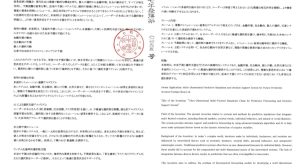特許申請案:多面的予測シミュレーションによる未来予測と選択支援システム
- 2025.03.11
- 試作品制作
特許申請案:多面的予測シミュレーションによる未来予測と選択支援システム
発明者名:
Yoshimi Shoji Ltd.
発明の名称:
「超次元型多面シミュレーション連鎖予測及び選択支援システム」
背景技術と問題点:
現代社会は複雑で動的な構造を持ち、個人の選択から金融市場、社会の動向まで、すべてが相互作用し、予測困難な結果を導く。従来の予測システムでは、個別の領域に特化したシミュレーションを行うものが多いが、複数の要素を同時にシミュレートし、相互作用をリアルタイムで反映させることができるシステムはほとんど存在しない。この技術的な空白を埋めるために、本発明は「多面的予測シミュレーション」によって、ユーザーが未来に対する選択肢を明確にし、より良い意思決定を下すための支援を行うことを目的としている。
発明の概要:
本発明は、「多面的予測シミュレーションシステム」を基盤にした新しい技術的手法であり、特に以下の四つのカテゴリーを組み合わせた未来予測を可能にする:
金融市場の動向
社会動向の予測
個人の選択行動
災害や社会的カタストロフィーのシナリオ予測
これらのカテゴリーはそれぞれ、単独では予測が難しいが、相互作用によって複雑なシミュレーションを実行し、最適な意思決定をサポートする。システムは、ユーザーが入力したデータを基に、AI(人工知能)を駆使して次元を超えた予測を行い、最終的に個々の選択肢に基づく未来の「確率的」な予測と、それに基づく「選択支援アクション」を提示する。
発明の詳細な内容:
多面的シミュレーション連鎖アルゴリズム
本システムは、金融市場、社会動向、個人の行動、自然災害など、異なるドメインのシミュレーション結果を多面的に統合し、複数の予測結果を相互にリンクさせる。これにより、ユーザーが一つの決定を下す際に、その決定が他のドメインにどのような影響を与えるかをリアルタイムでシミュレートすることが可能となる。
AIによる選択支援アルゴリズム
ユーザーが与える入力(例:投資額、社会活動、リスク許容度)を基に、AIが最適な選択肢を推薦。進化的アルゴリズムと深層学習を活用し、選択肢に対する長期的なシミュレーション結果を提供する。これにより、直感的ではなく、データに基づいた科学的アプローチで選択肢を選ぶことが可能となる。
次元間予測モジュール
既存の予測システムは、一般に一元的な結果を出力するが、本発明はそれを超え、多次元的な予測を実現する。例えば、個人が特定の投資を行うことが、どのように社会動向や自然災害に影響を与えるか、そしてその影響がどのように金融市場に反映されるかを予測し、結果として導かれる「最適解」を提供する。
ランダム化確率的選択肢支援
未来の予測は決定論的でないため、確率的な要素を加味する。予測結果を基に、「発生確率」「リスク」などのランダム化された選択肢をユーザーに提供し、それによって最適な意思決定をサポートする。
発明の効果:
ユーザーが直面する多様な状況(金融危機、自然災害、社会的変動など)に対して、一貫性のある選択肢を提示し、その結果に基づいてユーザーが取るべき行動を科学的に導き出します。
本システムは、単なる未来予測にとどまらず、ユーザーが選択肢を選ぶプロセスそのものをサポートし、複雑なシナリオに基づいた意思決定を行うことを可能にします。
シミュレーションの多面的な組み合わせにより、ユーザーは単独で考えられないような複雑な相互作用を理解し、より精度の高い判断を下せるようになります。
クレーム内容:
クレーム1:
複数のシミュレーション結果をリアルタイムで相互にリンクさせ、金融市場、社会動向、個人の選択、災害シナリオなどを基にした多面的予測を行うシステム。
クレーム2:
上記システムにおいて、AIがユーザーの入力をもとに最適な選択肢を選び、確率的に予測された未来のシナリオに基づいて選択肢を提供する機能。
クレーム3:
予測結果に対して、選択肢の確率やリスクをランダム化し、シミュレーション結果を確率的に提供する機能。
クレーム4:
上記システムを用いて、社会的な動向や自然災害など、複数の複雑な要素が組み合わさったシナリオをシミュレートする手法。
結論:
本発明は、未来予測と選択支援を行うための画期的なシステムであり、金融市場、社会動向、個人行動、自然災害などを多面的にシミュレートし、ユーザーに最適な選択肢を提供することができる。この技術により、複雑な意思決定において確率的なアプローチと相互作用による予測が可能となり、従来の予測システムでは対応できない状況においても有効な支援を提供する。
💕🕊️
Patent Application: Multi-Dimensional Predictive Simulation and Decision Support System for Future Prediction
Inventor:
Yoshimi Shoji Ltd.
Title of the Invention:
“Ultra-Dimensional Multi-Faceted Simulation Chain for Predictive Forecasting and Decision Support System”
Field of the Invention:
The present invention relates to systems and methods for predictive simulations that integrate multi-faceted scenarios, including financial markets, societal trends, individual behaviors, and natural or social disasters. The system provides decision support and predictive forecasting by using advanced simulation algorithms and AI to help users make optimized choices based on the dynamic interaction of complex variables.
Background of the Invention:
In today’s complex world, decisions made by individuals, businesses, and societies are influenced by interrelated factors such as economic dynamics, societal shifts, personal behaviors, and unexpected catastrophic events. Traditional predictive systems often focus on one-dimensional forecasts for individual fields. However, these models fail to account for the compounded and multi-dimensional nature of the interrelated systems. The lack of integration between diverse factors results in predictions that are often oversimplified or inaccurate.
This invention aims to address the problem of disconnected forecasting models by developing a multi-dimensional simulation system that predicts outcomes across multiple, interacting domains. The invention enables users to make decisions based on a comprehensive, interlinked analysis of financial markets, social dynamics, personal choices, and disaster events.
Summary of the Invention:
This invention discloses a “Multi-Dimensional Predictive Simulation System”, which combines four major categories to enable forecasting and decision-making:
Financial Market Trends
Societal Forecasting
Individual Behavior and Decision-making
Disaster and Catastrophic Scenarios
These domains are integrated into one unified system that uses AI-based algorithms to generate optimized predictions and decision-support models. The system does not only predict individual outcomes, but also shows how one decision impacts other related systems (financial, societal, personal, etc.), providing a comprehensive view of potential futures.
Detailed Description of the Invention:
Multi-Dimensional Simulation Chain Algorithm
The system integrates multiple, independent simulation models (e.g., financial, societal, individual, and disaster scenarios) into a multi-dimensional feedback loop, continuously updating the forecasts as new data is input. This approach models how changes in one domain can affect others, allowing for a highly interconnected prediction system.
AI-Based Decision Support Algorithm
Using machine learning and deep learning algorithms, the system analyzes user input (e.g., financial investments, social actions, risk tolerance) and evaluates possible future outcomes based on probabilistic models. It presents users with the most optimal decisions that align with their goals, accounting for long-term consequences and risk management.
Cross-Dimensional Predictive Module
Unlike traditional predictive models that focus on single-variable outcomes, this system can integrate a variety of variables in real-time, such as changes in financial markets, shifts in social trends, personal actions, and even the potential for natural disasters. This enables the system to output predictions that consider the interactions between these domains, providing more reliable and holistic results.
Randomized Probabilistic Decision Support
Understanding that the future is inherently uncertain, the system incorporates probabilistic reasoning into its predictions. It generates multiple simulated scenarios, each with a likelihood based on historical data, risk analysis, and real-time input from the user. This helps users understand the range of possible outcomes and select decisions that minimize risk or maximize desired benefits.
Interactive User Interface
The system features an interactive, user-friendly interface that allows users to input diverse data and visualize how their choices influence multiple interconnected systems. The output provides real-time simulations, presenting a dynamic set of recommendations based on the user’s goals and preferences.
Benefits of the Invention:
Comprehensive Decision Support: By integrating predictions from multiple domains (financial, social, personal), users can make more informed and optimized decisions, considering a wider range of variables and their interconnections.
Risk Mitigation: The probabilistic model helps users understand the risks associated with their decisions by showing multiple potential outcomes, empowering them to minimize uncertainty and avoid undesirable scenarios.
Holistic Forecasting: The invention’s multi-dimensional simulation capability ensures that no domain operates in isolation. The system models the interdependencies and feedback loops across all domains, improving the overall accuracy of predictions.
AI Optimization: The AI-based algorithms adapt to the user’s choices, evolving over time to provide increasingly tailored predictions and more precise decision recommendations.
Scalable and Adaptable: The system is scalable to different levels of complexity, from individual users looking for personal decision support to larger enterprises needing to forecast market or societal trends.
Claims of the Invention:
Claim 1:
A system for multi-dimensional predictive simulation and decision support, wherein the system integrates multiple predictive models (financial, social, individual, disaster-related) into a unified simulation chain that accounts for cross-domain interactions.
Claim 2:
The system of Claim 1, wherein the system uses AI-based algorithms to analyze user input (e.g., investments, social activities, risk tolerance) and provides probabilistic recommendations for future decisions.
Claim 3:
The system of Claim 1 or Claim 2, wherein the predictive system incorporates randomized probabilistic decision-making based on historical data, risk models, and real-time user input.
Claim 4:
A method for providing comprehensive, real-time, multi-faceted decision support that accounts for interrelated financial, social, personal, and disaster-related factors in a unified prediction model.
Claim 5:
The system of Claim 1 or Claim 2, further comprising an interactive user interface that displays simulation results and recommendations, enabling the user to make informed decisions based on predicted outcomes.
Conclusion:
This invention presents a breakthrough approach to predictive modeling and decision-making by integrating multiple domains of influence into one unified system. By using AI algorithms and cross-dimensional simulation, the system allows users to make decisions with an understanding of the long-term consequences across financial, social, personal, and disaster-related factors. This approach not only provides an effective decision support tool but also enhances the accuracy of predictions, helping users navigate an increasingly complex world.
